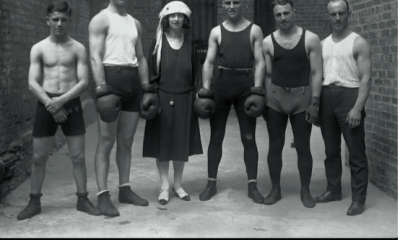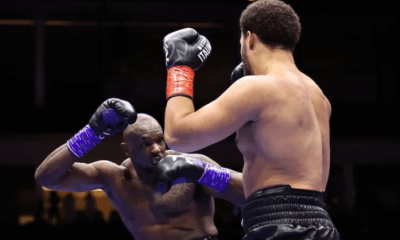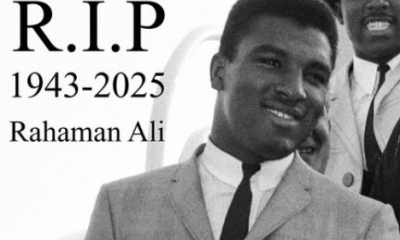Articles of 2007
Is Forrest Too Calm For A Chaotic Sport?
They say patience is a virtue. In the world of professional boxing it can be a vice.
Today, the most impatient fighter in the world also happens to be the pound-for-pound best. Floyd Mayweather’s punches move like the speed of light, and so has his career.
Three years after the 1996 Olympian made his paid debut, he audaciously challenged the highly respected Genaro Hernandez to win the 130lb championship. Nine years later, the Pretty Boy’s impetuosity has turned him into a five-weight titlist, having defeated eleven beltholders along the way.
Mayweather also possesses alarming impulsiveness outside the squared circle, a characteristic the champion demonstrated on HBO’s reality series 24/7 as he unashamedly bragged about his blatant lust for materialistic wealth. Nonetheless, that unflinching boldness probably contributed to his last fight being the most profitable event in boxing history.
Contrast Mayweather’s form with that of a fighter who also left the amateur ranks on the back of an Olympic Games appearance. Vernon Forrest turned pro in November 1992, but unlike Floyd he displayed an apparent lack of hastiness both in and out of the ring, having to wait nearly eight years before he got his first world title shot, a less than glamorous affair against welterweight Raul Frank. The outcome fitted the occasion as a clash of heads resulted in a disappointing no-contest.
Standing behind a snakelike jab and sharp right hand, the 6-foot tall Forrest was content to win the rematch at a measured pace and, just like in his 31 previous victories, devoid of any unnecessary drama – a strategy that subsequently resulted in him being overlooked by the top cable networks.
Eventually the Atlanta, Georgia native reached the big time as two unexpected victories over the then pound-for-pound king Shane Mosley earned him Fighter of the Year honors in 2002, along with a lucrative HBO contract. Still, his arduous decade-long ascent to the upper echelon of the sport indicated that The Viper may be more contemplative than combative.
Whereas a fighter like Mayweather was brought up on boxing, Forrest came across the sport by chance and from an early age displayed a tendency toward long-term thinking.
When he was nine years old, Forrest received a three-day suspension from the neighborhood boys’ club for displaying a pugilistic attitude at a less than inappropriate occasion. With nothing else to do, the bored youngster ambled into the gym around the corner from his home. At that moment his future became clear.
“My whole life has been a game plan,” Forrest told The Ring in 2002. “When I first walked into the gym I knew I was going to be a boxer. I was going to make money in boxing, and take that money and develop Vernon Forrest Enterprises, which would be a collection of businesses. I just knew I was going to be a business mogul.”
And he has certainly made good on his aspirations. In 1998, having accrued a relatively modest income from the fight game, Forrest and a couple of partners set up Destiny’s Child Inc, a business designed to aid the mentally disabled.
But he didn’t establish the organization just to boost his finances. The fighter took a hands-on approach in the running of his enterprise and actually lived in the same house as his clients, resulting in an experience that would ultimately shape his outlook on life.
“People ask me all the time, ‘How come you’re so patient? How come you don’t let stuff bother you?’ They don’t understand what my clients go through,” explained Forrest. “This boxing is like sleepwalking in comparison.
“The people we look after are people who nobody had faith in, but we believed in them. And because we believed in them and worked so hard with them, they are overcoming obstacles by leaps and bounds.”
The strength of his rapport with the Destiny’s Child clients was evident after he defeated Mosley for the second time at the Conseco Fieldhouse in Indianapolis. Instead of taking the opportunity to crow about the highest profile victory of his career in front of the HBO cameras, Forrest climbed into the stands immediately after the result was announced to celebrate with the group he called his “special people”.
Unfortunately, Forrest’s breakout party ended as suddenly as it started with a shocking loss to the lightly-regarded slugger Ricardo Mayorga in January 2003. After tasting defeat again in the rematch six months later, many observers began to question whether Forrest really had the mentality to be an elite fighter.
“Forrest comes out and shocks everyone by knocking off a prime Shane Mosley, a guy who seems to be near invincible at the time,” said boxing writer Ted Bodenrader. “Yet, Forrest is then taken out by the limited Ricardo Mayorga, who has since been proven to be nothing more than a B-level guy.
“Mayorga then busts up Forrest a second time, and it makes everyone question how good Forrest really is. In retrospect, it shows that Forrest may have difficulty with wild, straight-forward sluggers like Mayorga. I also believe he may be susceptible to intimidation and that his problems with Mayorga may have been more psychological than anything.”
While his second meeting with Mayorga was more competitive, Forrest was no more assertive, seemingly fighting within himself en route to a close points loss. What’s more, his lust for battle appeared to be dampened further after the defeat, with a prolonged two-year absence from the ring apparently ending his tenure as a high caliber contender.
But Forrest insists his hiatus was due to injuries incurred in advance of the Mayorga bouts and that he wasn’t fighting at full health for a number of years.
“Before I got the marquee fights I couldn’t afford to take a break,” he said. “So when it was time to fight and my arm would hurt, I’d just get a cortisone shot. And then once I got in the position to get recognition and start making the kind of money that I needed and wanted to make, then it’s like, ‘well you can’t just stop now’.
“So I had rotator cuff damages and I was protecting my shoulder in the way I threw punches, and that ended up damaging my elbow so I ended up having surgery on my shoulder and my elbow, and that didn’t work and I ended up having another surgery on my shoulder.”
Since his return in 2005 (“Don’t call it a comeback,” he insists) Forrest has won a couple of tune-up bouts and a razor-close decision over fellow veteran Ike Quartey last August.
Again, Forrest’s performance gave little indication towards his true ability, with some observers criticizing him for doing too much thinking instead of fighting. It was a closely contested and somewhat controversial affair with many fans deeming the decision highly debatable. However, in a grim reflection of Forrest’s popularity, it’s possible that Quartey’s vocal African supporters may have influenced onlookers, as their loud objections to the scoring resonated around the Theatre at Madison Square Garden.
Yet even though Forrest, 38-2 (28), was awarded the victory, it was Quartey who did the better maneuvering outside the ring to secure a high profile bout with Ronald ‘Winky’ Wright, while the Georgian was again left pondering his future on the sidelines.
At the advanced age of 36, The Viper should probably be questioning the impact he can now make on the sport. But then again, never underestimate the ability of a deep thinker to find inspiration.
“When I saw Bernard Hopkins beat [Felix] Trinidad [in 2001], it was my greatest motivation,” he said. “Bernard and me are much alike, we’re both old-school, cut from the same cloth. We’ve both had to deal with setbacks and boxing politics.”
When a fighter is getting on in years, it’s not a bad idea for him to use a freakishly fresh 42-year-old legend as a role model. But is a proposed showdown with an ageing former champion like Carlos Baldomir a step in the right direction for Forrest?
“The fight with Baldomir will reveal to a degree where he is at, perhaps serving as somewhat of a measuring stick,” said Bodenrader. “Baldomir is coming off consecutive meetings with Arturo Gatti and Floyd Mayweather, so it will show where Forrest fits into the mix.
“If Forrest can go out and put on an impressive display against this guy, it will further define him as a legitimate player in today’s landscape. But he needs to follow it up with something immediately, and not allow substantial time to go by without another fight. Vernon is one of those guys you can forget about rather quickly.”
The enigmatic nature of Forrest is clearly perceptible. He’s a man who makes a living from organized violence, yet provides care for the disabled; defeats the world’s best fighter, but loses to the crudest, all while maintaining unwavering calmness in a business plagued by corruption.
With such a complex character there can only be one definite outcome in his next fight: we won’t know Vernon Forrest any better.
-

 Featured Articles4 weeks ago
Featured Articles4 weeks agoThe Hauser Report: Zayas-Garcia, Pacquiao, Usyk, and the NYSAC
-

 Featured Articles3 weeks ago
Featured Articles3 weeks agoOscar Duarte and Regis Prograis Prevail on an Action-Packed Fight Card in Chicago
-

 Featured Articles2 weeks ago
Featured Articles2 weeks agoThe Hauser Report: Cinematic and Literary Notes
-

 Book Review2 weeks ago
Book Review2 weeks agoMark Kriegel’s New Book About Mike Tyson is a Must-Read
-

 Featured Articles3 days ago
Featured Articles3 days agoThe Hauser Report: Debunking Two Myths and Other Notes
-

 Featured Articles4 weeks ago
Featured Articles4 weeks agoRemembering Dwight Muhammad Qawi (1953-2025) and his Triumphant Return to Prison
-

 Featured Articles1 week ago
Featured Articles1 week agoMoses Itauma Continues his Rapid Rise; Steamrolls Dillian Whyte in Riyadh
-

 Featured Articles3 weeks ago
Featured Articles3 weeks agoRahaman Ali (1943-2025)















